Grant Application: Improving Mental Health for Indigenous Prisoners
VerifiedAdded on 2020/04/21
|13
|3255
|94
Project
AI Summary
This grant application addresses the critical mental health and health disparities faced by Indigenous prisoners, particularly women, in Australia. The application highlights the disproportionately high rates of incarceration among Aboriginal women, their poor health conditions, and exposure to sexually transmitted infections, physical and sexual abuse, and mental health issues like anxiety, depression, and PTSD. The project proposes a qualitative descriptive research study involving interviews with Indigenous female inmates to understand the root causes of their mental health problems, including social, economic, and cultural factors, and to identify potential solutions. The objectives include identifying the issues, conducting surveys and interviews, and analyzing the root causes to develop feasible solutions. The project is structured using the SMART framework, ensuring that the objectives are specific, measurable, attainable, realistic, and timely, with a budget of $2,500 and a timeline spanning eight weeks. The evaluation phase will assess the correlation between the prisoners' psychological state and their socio-economic position to inform future research and recommendations for improved mental health interventions.
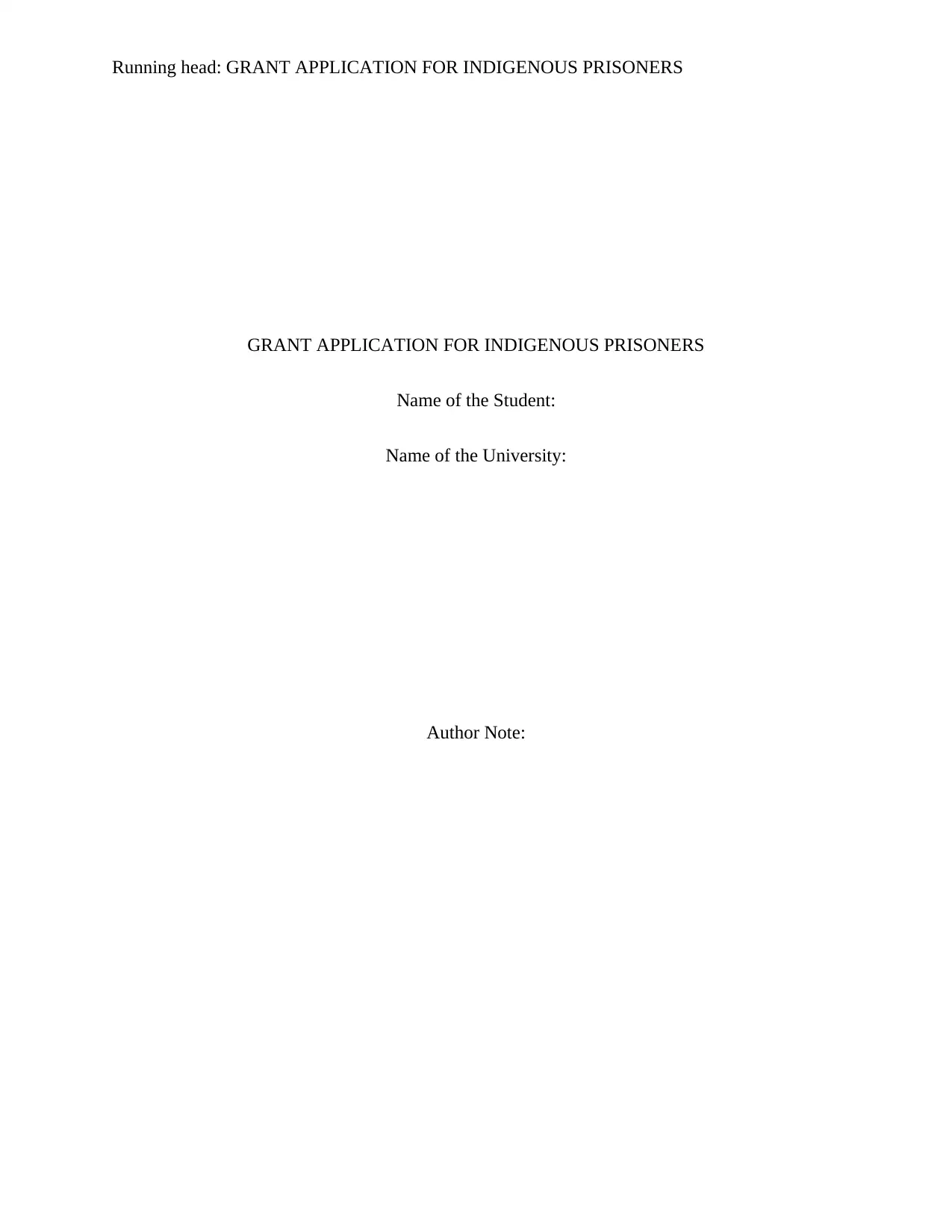
Running head: GRANT APPLICATION FOR INDIGENOUS PRISONERS
GRANT APPLICATION FOR INDIGENOUS PRISONERS
Name of the Student:
Name of the University:
Author Note:
GRANT APPLICATION FOR INDIGENOUS PRISONERS
Name of the Student:
Name of the University:
Author Note:
Paraphrase This Document
Need a fresh take? Get an instant paraphrase of this document with our AI Paraphraser
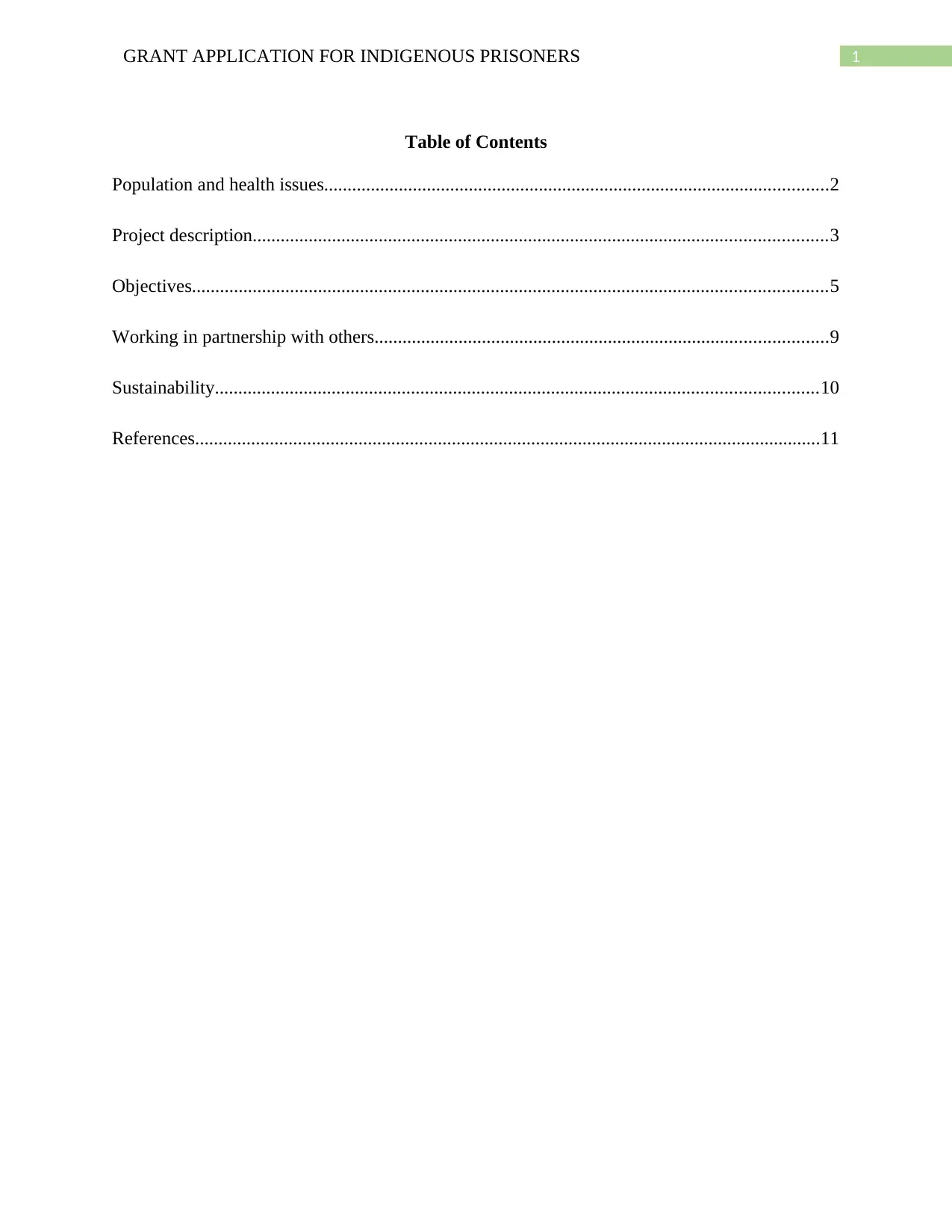
1GRANT APPLICATION FOR INDIGENOUS PRISONERS
Table of Contents
Population and health issues............................................................................................................2
Project description...........................................................................................................................3
Objectives........................................................................................................................................5
Working in partnership with others.................................................................................................9
Sustainability.................................................................................................................................10
References......................................................................................................................................11
Table of Contents
Population and health issues............................................................................................................2
Project description...........................................................................................................................3
Objectives........................................................................................................................................5
Working in partnership with others.................................................................................................9
Sustainability.................................................................................................................................10
References......................................................................................................................................11
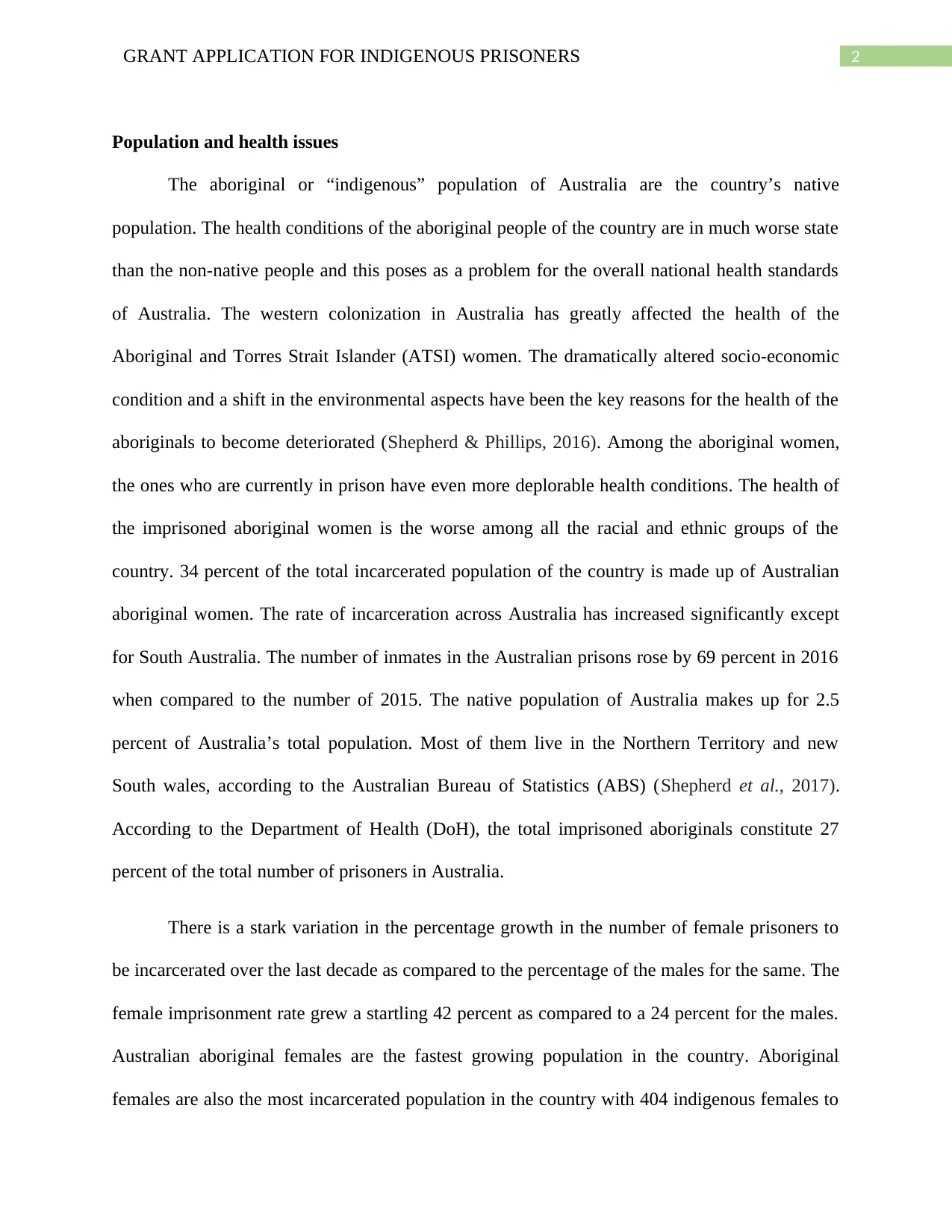
2GRANT APPLICATION FOR INDIGENOUS PRISONERS
Population and health issues
The aboriginal or “indigenous” population of Australia are the country’s native
population. The health conditions of the aboriginal people of the country are in much worse state
than the non-native people and this poses as a problem for the overall national health standards
of Australia. The western colonization in Australia has greatly affected the health of the
Aboriginal and Torres Strait Islander (ATSI) women. The dramatically altered socio-economic
condition and a shift in the environmental aspects have been the key reasons for the health of the
aboriginals to become deteriorated (Shepherd & Phillips, 2016). Among the aboriginal women,
the ones who are currently in prison have even more deplorable health conditions. The health of
the imprisoned aboriginal women is the worse among all the racial and ethnic groups of the
country. 34 percent of the total incarcerated population of the country is made up of Australian
aboriginal women. The rate of incarceration across Australia has increased significantly except
for South Australia. The number of inmates in the Australian prisons rose by 69 percent in 2016
when compared to the number of 2015. The native population of Australia makes up for 2.5
percent of Australia’s total population. Most of them live in the Northern Territory and new
South wales, according to the Australian Bureau of Statistics (ABS) (Shepherd et al., 2017).
According to the Department of Health (DoH), the total imprisoned aboriginals constitute 27
percent of the total number of prisoners in Australia.
There is a stark variation in the percentage growth in the number of female prisoners to
be incarcerated over the last decade as compared to the percentage of the males for the same. The
female imprisonment rate grew a startling 42 percent as compared to a 24 percent for the males.
Australian aboriginal females are the fastest growing population in the country. Aboriginal
females are also the most incarcerated population in the country with 404 indigenous females to
Population and health issues
The aboriginal or “indigenous” population of Australia are the country’s native
population. The health conditions of the aboriginal people of the country are in much worse state
than the non-native people and this poses as a problem for the overall national health standards
of Australia. The western colonization in Australia has greatly affected the health of the
Aboriginal and Torres Strait Islander (ATSI) women. The dramatically altered socio-economic
condition and a shift in the environmental aspects have been the key reasons for the health of the
aboriginals to become deteriorated (Shepherd & Phillips, 2016). Among the aboriginal women,
the ones who are currently in prison have even more deplorable health conditions. The health of
the imprisoned aboriginal women is the worse among all the racial and ethnic groups of the
country. 34 percent of the total incarcerated population of the country is made up of Australian
aboriginal women. The rate of incarceration across Australia has increased significantly except
for South Australia. The number of inmates in the Australian prisons rose by 69 percent in 2016
when compared to the number of 2015. The native population of Australia makes up for 2.5
percent of Australia’s total population. Most of them live in the Northern Territory and new
South wales, according to the Australian Bureau of Statistics (ABS) (Shepherd et al., 2017).
According to the Department of Health (DoH), the total imprisoned aboriginals constitute 27
percent of the total number of prisoners in Australia.
There is a stark variation in the percentage growth in the number of female prisoners to
be incarcerated over the last decade as compared to the percentage of the males for the same. The
female imprisonment rate grew a startling 42 percent as compared to a 24 percent for the males.
Australian aboriginal females are the fastest growing population in the country. Aboriginal
females are also the most incarcerated population in the country with 404 indigenous females to
⊘ This is a preview!⊘
Do you want full access?
Subscribe today to unlock all pages.

Trusted by 1+ million students worldwide
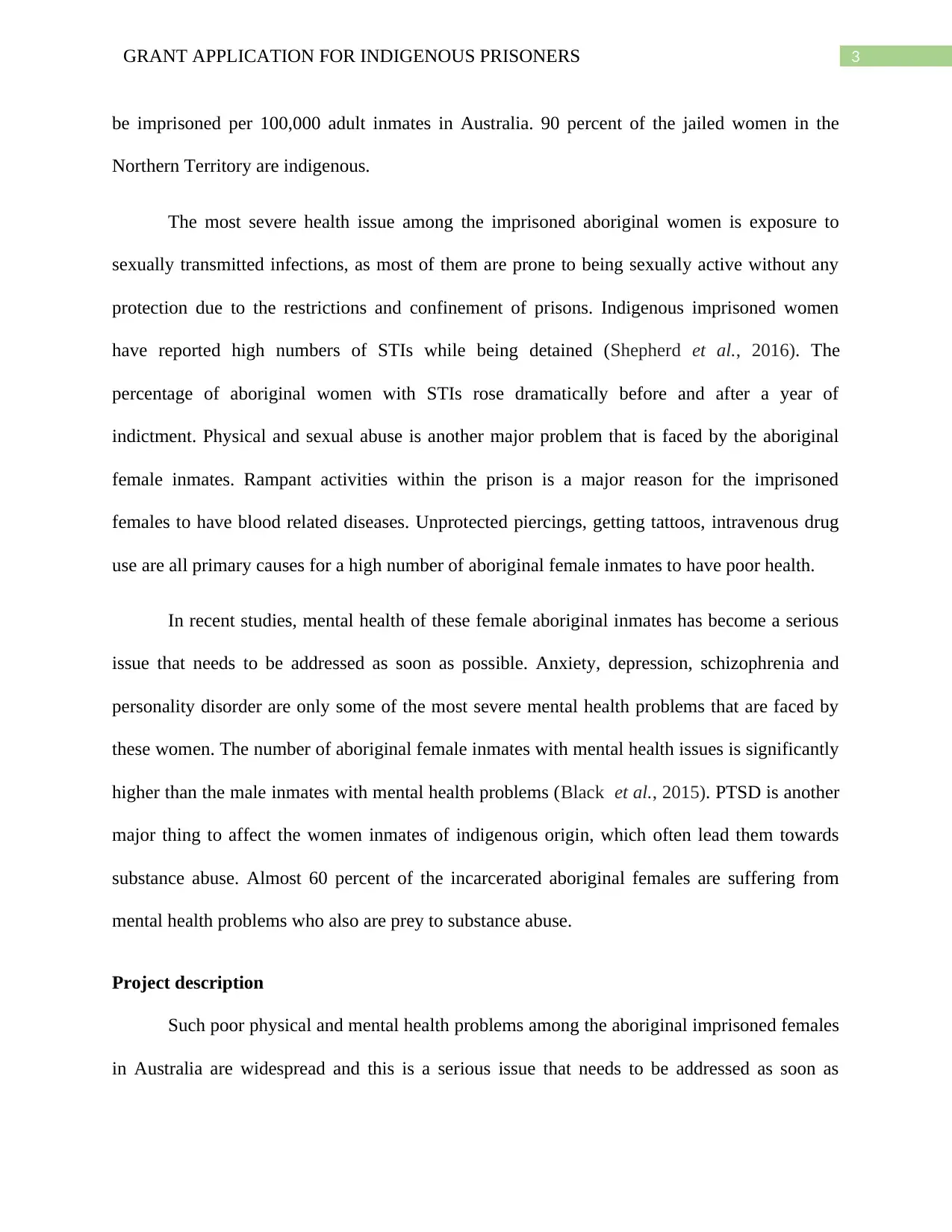
3GRANT APPLICATION FOR INDIGENOUS PRISONERS
be imprisoned per 100,000 adult inmates in Australia. 90 percent of the jailed women in the
Northern Territory are indigenous.
The most severe health issue among the imprisoned aboriginal women is exposure to
sexually transmitted infections, as most of them are prone to being sexually active without any
protection due to the restrictions and confinement of prisons. Indigenous imprisoned women
have reported high numbers of STIs while being detained (Shepherd et al., 2016). The
percentage of aboriginal women with STIs rose dramatically before and after a year of
indictment. Physical and sexual abuse is another major problem that is faced by the aboriginal
female inmates. Rampant activities within the prison is a major reason for the imprisoned
females to have blood related diseases. Unprotected piercings, getting tattoos, intravenous drug
use are all primary causes for a high number of aboriginal female inmates to have poor health.
In recent studies, mental health of these female aboriginal inmates has become a serious
issue that needs to be addressed as soon as possible. Anxiety, depression, schizophrenia and
personality disorder are only some of the most severe mental health problems that are faced by
these women. The number of aboriginal female inmates with mental health issues is significantly
higher than the male inmates with mental health problems (Black et al., 2015). PTSD is another
major thing to affect the women inmates of indigenous origin, which often lead them towards
substance abuse. Almost 60 percent of the incarcerated aboriginal females are suffering from
mental health problems who also are prey to substance abuse.
Project description
Such poor physical and mental health problems among the aboriginal imprisoned females
in Australia are widespread and this is a serious issue that needs to be addressed as soon as
be imprisoned per 100,000 adult inmates in Australia. 90 percent of the jailed women in the
Northern Territory are indigenous.
The most severe health issue among the imprisoned aboriginal women is exposure to
sexually transmitted infections, as most of them are prone to being sexually active without any
protection due to the restrictions and confinement of prisons. Indigenous imprisoned women
have reported high numbers of STIs while being detained (Shepherd et al., 2016). The
percentage of aboriginal women with STIs rose dramatically before and after a year of
indictment. Physical and sexual abuse is another major problem that is faced by the aboriginal
female inmates. Rampant activities within the prison is a major reason for the imprisoned
females to have blood related diseases. Unprotected piercings, getting tattoos, intravenous drug
use are all primary causes for a high number of aboriginal female inmates to have poor health.
In recent studies, mental health of these female aboriginal inmates has become a serious
issue that needs to be addressed as soon as possible. Anxiety, depression, schizophrenia and
personality disorder are only some of the most severe mental health problems that are faced by
these women. The number of aboriginal female inmates with mental health issues is significantly
higher than the male inmates with mental health problems (Black et al., 2015). PTSD is another
major thing to affect the women inmates of indigenous origin, which often lead them towards
substance abuse. Almost 60 percent of the incarcerated aboriginal females are suffering from
mental health problems who also are prey to substance abuse.
Project description
Such poor physical and mental health problems among the aboriginal imprisoned females
in Australia are widespread and this is a serious issue that needs to be addressed as soon as
Paraphrase This Document
Need a fresh take? Get an instant paraphrase of this document with our AI Paraphraser
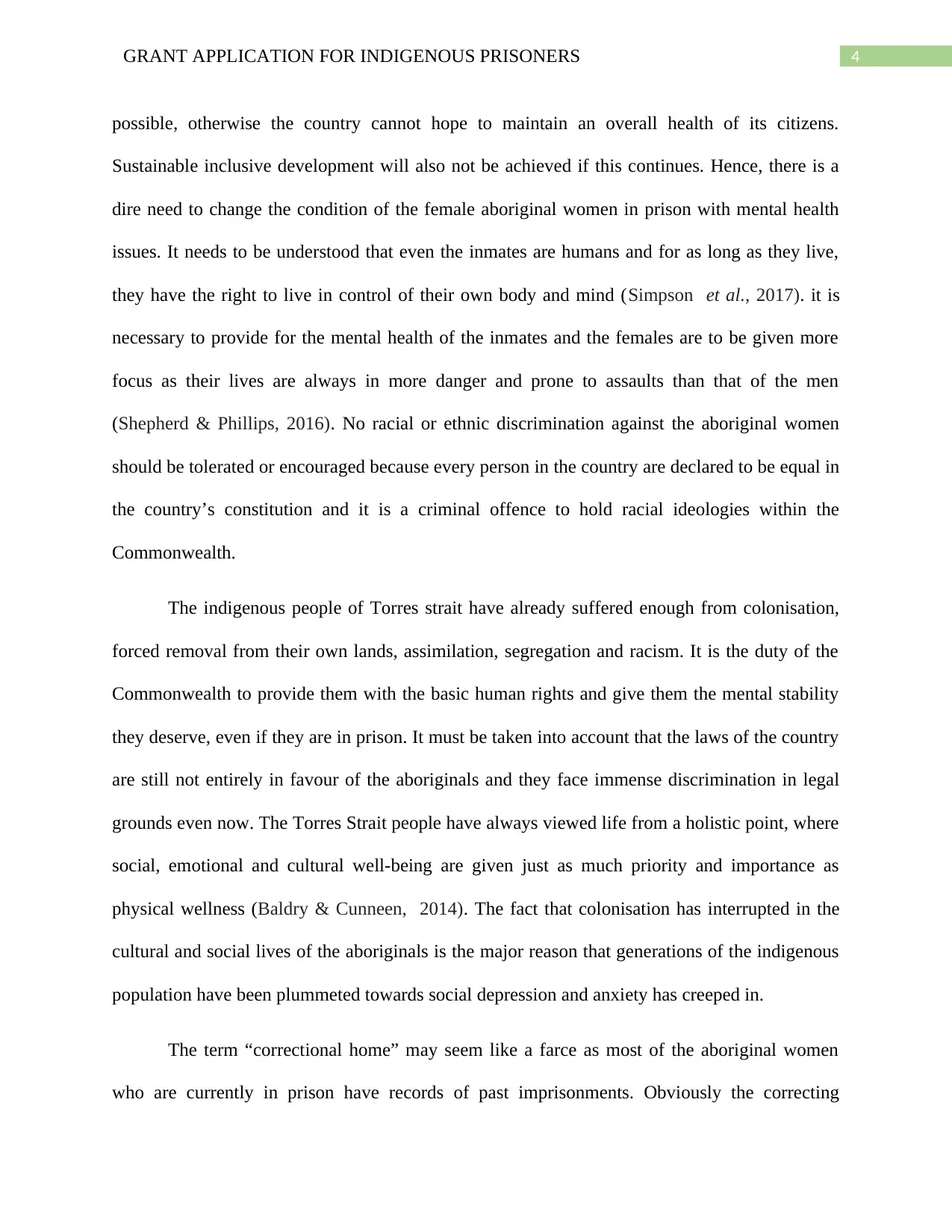
4GRANT APPLICATION FOR INDIGENOUS PRISONERS
possible, otherwise the country cannot hope to maintain an overall health of its citizens.
Sustainable inclusive development will also not be achieved if this continues. Hence, there is a
dire need to change the condition of the female aboriginal women in prison with mental health
issues. It needs to be understood that even the inmates are humans and for as long as they live,
they have the right to live in control of their own body and mind (Simpson et al., 2017). it is
necessary to provide for the mental health of the inmates and the females are to be given more
focus as their lives are always in more danger and prone to assaults than that of the men
(Shepherd & Phillips, 2016). No racial or ethnic discrimination against the aboriginal women
should be tolerated or encouraged because every person in the country are declared to be equal in
the country’s constitution and it is a criminal offence to hold racial ideologies within the
Commonwealth.
The indigenous people of Torres strait have already suffered enough from colonisation,
forced removal from their own lands, assimilation, segregation and racism. It is the duty of the
Commonwealth to provide them with the basic human rights and give them the mental stability
they deserve, even if they are in prison. It must be taken into account that the laws of the country
are still not entirely in favour of the aboriginals and they face immense discrimination in legal
grounds even now. The Torres Strait people have always viewed life from a holistic point, where
social, emotional and cultural well-being are given just as much priority and importance as
physical wellness (Baldry & Cunneen, 2014). The fact that colonisation has interrupted in the
cultural and social lives of the aboriginals is the major reason that generations of the indigenous
population have been plummeted towards social depression and anxiety has creeped in.
The term “correctional home” may seem like a farce as most of the aboriginal women
who are currently in prison have records of past imprisonments. Obviously the correcting
possible, otherwise the country cannot hope to maintain an overall health of its citizens.
Sustainable inclusive development will also not be achieved if this continues. Hence, there is a
dire need to change the condition of the female aboriginal women in prison with mental health
issues. It needs to be understood that even the inmates are humans and for as long as they live,
they have the right to live in control of their own body and mind (Simpson et al., 2017). it is
necessary to provide for the mental health of the inmates and the females are to be given more
focus as their lives are always in more danger and prone to assaults than that of the men
(Shepherd & Phillips, 2016). No racial or ethnic discrimination against the aboriginal women
should be tolerated or encouraged because every person in the country are declared to be equal in
the country’s constitution and it is a criminal offence to hold racial ideologies within the
Commonwealth.
The indigenous people of Torres strait have already suffered enough from colonisation,
forced removal from their own lands, assimilation, segregation and racism. It is the duty of the
Commonwealth to provide them with the basic human rights and give them the mental stability
they deserve, even if they are in prison. It must be taken into account that the laws of the country
are still not entirely in favour of the aboriginals and they face immense discrimination in legal
grounds even now. The Torres Strait people have always viewed life from a holistic point, where
social, emotional and cultural well-being are given just as much priority and importance as
physical wellness (Baldry & Cunneen, 2014). The fact that colonisation has interrupted in the
cultural and social lives of the aboriginals is the major reason that generations of the indigenous
population have been plummeted towards social depression and anxiety has creeped in.
The term “correctional home” may seem like a farce as most of the aboriginal women
who are currently in prison have records of past imprisonments. Obviously the correcting
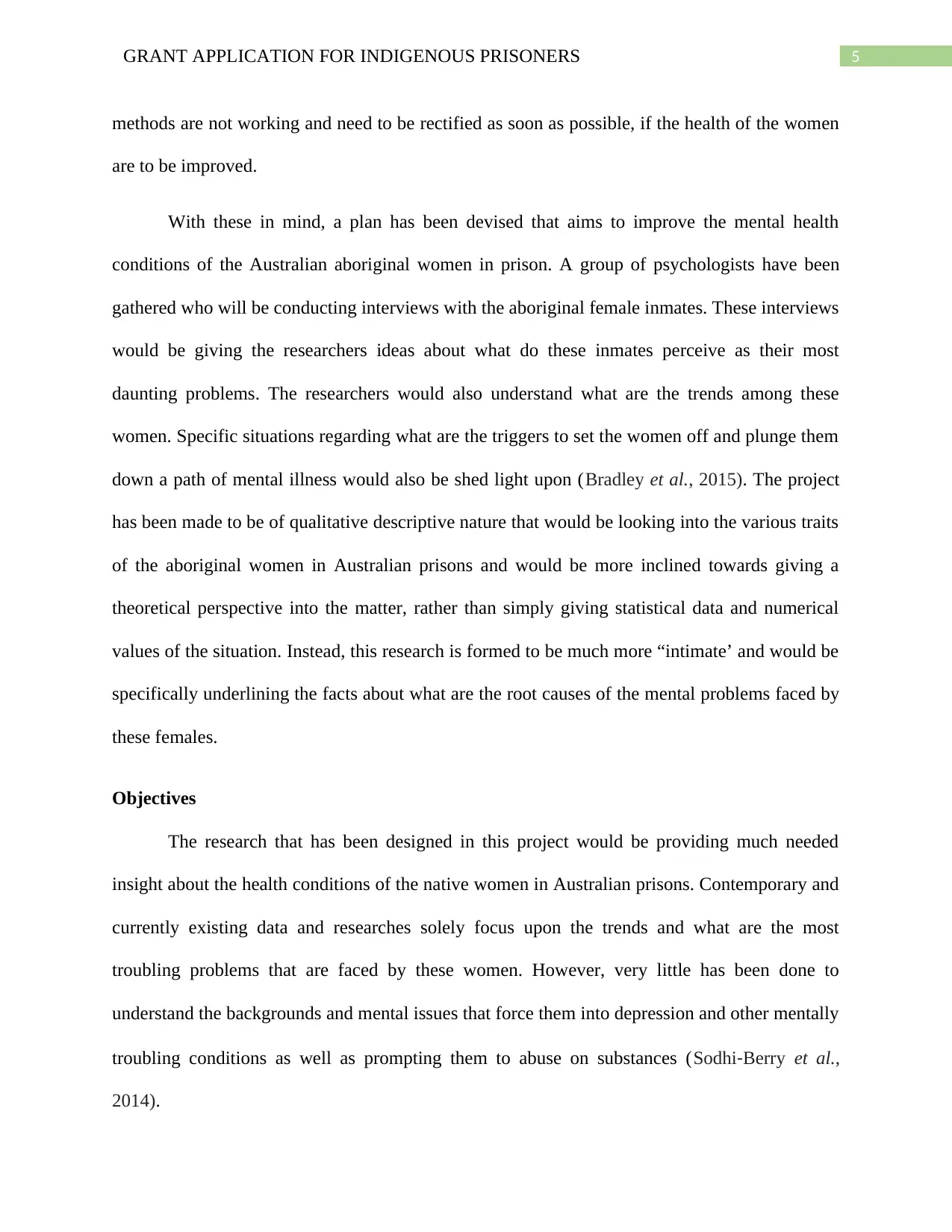
5GRANT APPLICATION FOR INDIGENOUS PRISONERS
methods are not working and need to be rectified as soon as possible, if the health of the women
are to be improved.
With these in mind, a plan has been devised that aims to improve the mental health
conditions of the Australian aboriginal women in prison. A group of psychologists have been
gathered who will be conducting interviews with the aboriginal female inmates. These interviews
would be giving the researchers ideas about what do these inmates perceive as their most
daunting problems. The researchers would also understand what are the trends among these
women. Specific situations regarding what are the triggers to set the women off and plunge them
down a path of mental illness would also be shed light upon (Bradley et al., 2015). The project
has been made to be of qualitative descriptive nature that would be looking into the various traits
of the aboriginal women in Australian prisons and would be more inclined towards giving a
theoretical perspective into the matter, rather than simply giving statistical data and numerical
values of the situation. Instead, this research is formed to be much more “intimate’ and would be
specifically underlining the facts about what are the root causes of the mental problems faced by
these females.
Objectives
The research that has been designed in this project would be providing much needed
insight about the health conditions of the native women in Australian prisons. Contemporary and
currently existing data and researches solely focus upon the trends and what are the most
troubling problems that are faced by these women. However, very little has been done to
understand the backgrounds and mental issues that force them into depression and other mentally
troubling conditions as well as prompting them to abuse on substances (Sodhi‐Berry et al.,
2014).
methods are not working and need to be rectified as soon as possible, if the health of the women
are to be improved.
With these in mind, a plan has been devised that aims to improve the mental health
conditions of the Australian aboriginal women in prison. A group of psychologists have been
gathered who will be conducting interviews with the aboriginal female inmates. These interviews
would be giving the researchers ideas about what do these inmates perceive as their most
daunting problems. The researchers would also understand what are the trends among these
women. Specific situations regarding what are the triggers to set the women off and plunge them
down a path of mental illness would also be shed light upon (Bradley et al., 2015). The project
has been made to be of qualitative descriptive nature that would be looking into the various traits
of the aboriginal women in Australian prisons and would be more inclined towards giving a
theoretical perspective into the matter, rather than simply giving statistical data and numerical
values of the situation. Instead, this research is formed to be much more “intimate’ and would be
specifically underlining the facts about what are the root causes of the mental problems faced by
these females.
Objectives
The research that has been designed in this project would be providing much needed
insight about the health conditions of the native women in Australian prisons. Contemporary and
currently existing data and researches solely focus upon the trends and what are the most
troubling problems that are faced by these women. However, very little has been done to
understand the backgrounds and mental issues that force them into depression and other mentally
troubling conditions as well as prompting them to abuse on substances (Sodhi‐Berry et al.,
2014).
⊘ This is a preview!⊘
Do you want full access?
Subscribe today to unlock all pages.

Trusted by 1+ million students worldwide
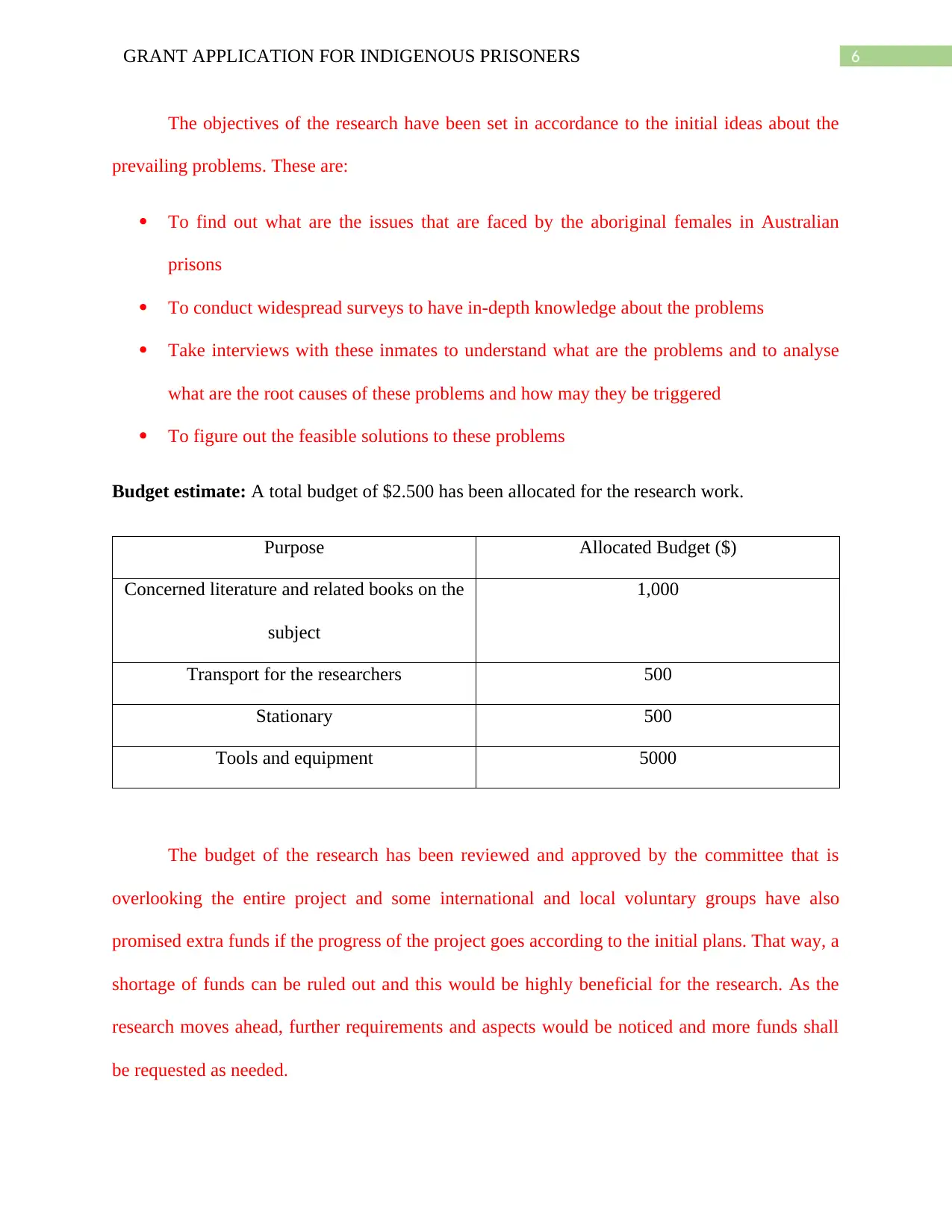
6GRANT APPLICATION FOR INDIGENOUS PRISONERS
The objectives of the research have been set in accordance to the initial ideas about the
prevailing problems. These are:
To find out what are the issues that are faced by the aboriginal females in Australian
prisons
To conduct widespread surveys to have in-depth knowledge about the problems
Take interviews with these inmates to understand what are the problems and to analyse
what are the root causes of these problems and how may they be triggered
To figure out the feasible solutions to these problems
Budget estimate: A total budget of $2.500 has been allocated for the research work.
Purpose Allocated Budget ($)
Concerned literature and related books on the
subject
1,000
Transport for the researchers 500
Stationary 500
Tools and equipment 5000
The budget of the research has been reviewed and approved by the committee that is
overlooking the entire project and some international and local voluntary groups have also
promised extra funds if the progress of the project goes according to the initial plans. That way, a
shortage of funds can be ruled out and this would be highly beneficial for the research. As the
research moves ahead, further requirements and aspects would be noticed and more funds shall
be requested as needed.
The objectives of the research have been set in accordance to the initial ideas about the
prevailing problems. These are:
To find out what are the issues that are faced by the aboriginal females in Australian
prisons
To conduct widespread surveys to have in-depth knowledge about the problems
Take interviews with these inmates to understand what are the problems and to analyse
what are the root causes of these problems and how may they be triggered
To figure out the feasible solutions to these problems
Budget estimate: A total budget of $2.500 has been allocated for the research work.
Purpose Allocated Budget ($)
Concerned literature and related books on the
subject
1,000
Transport for the researchers 500
Stationary 500
Tools and equipment 5000
The budget of the research has been reviewed and approved by the committee that is
overlooking the entire project and some international and local voluntary groups have also
promised extra funds if the progress of the project goes according to the initial plans. That way, a
shortage of funds can be ruled out and this would be highly beneficial for the research. As the
research moves ahead, further requirements and aspects would be noticed and more funds shall
be requested as needed.
Paraphrase This Document
Need a fresh take? Get an instant paraphrase of this document with our AI Paraphraser
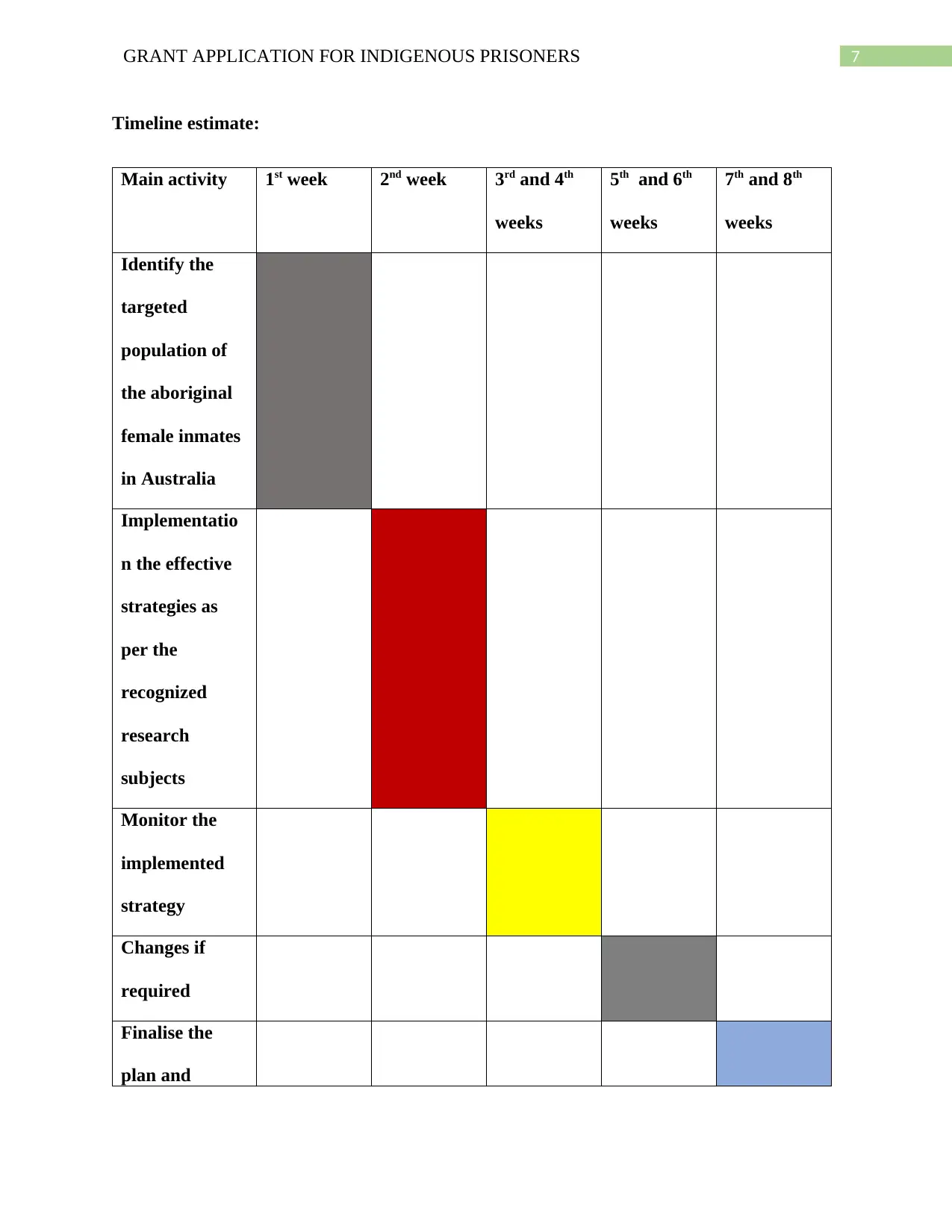
7GRANT APPLICATION FOR INDIGENOUS PRISONERS
Timeline estimate:
Main activity 1st week 2nd week 3rd and 4th
weeks
5th and 6th
weeks
7th and 8th
weeks
Identify the
targeted
population of
the aboriginal
female inmates
in Australia
Implementatio
n the effective
strategies as
per the
recognized
research
subjects
Monitor the
implemented
strategy
Changes if
required
Finalise the
plan and
Timeline estimate:
Main activity 1st week 2nd week 3rd and 4th
weeks
5th and 6th
weeks
7th and 8th
weeks
Identify the
targeted
population of
the aboriginal
female inmates
in Australia
Implementatio
n the effective
strategies as
per the
recognized
research
subjects
Monitor the
implemented
strategy
Changes if
required
Finalise the
plan and
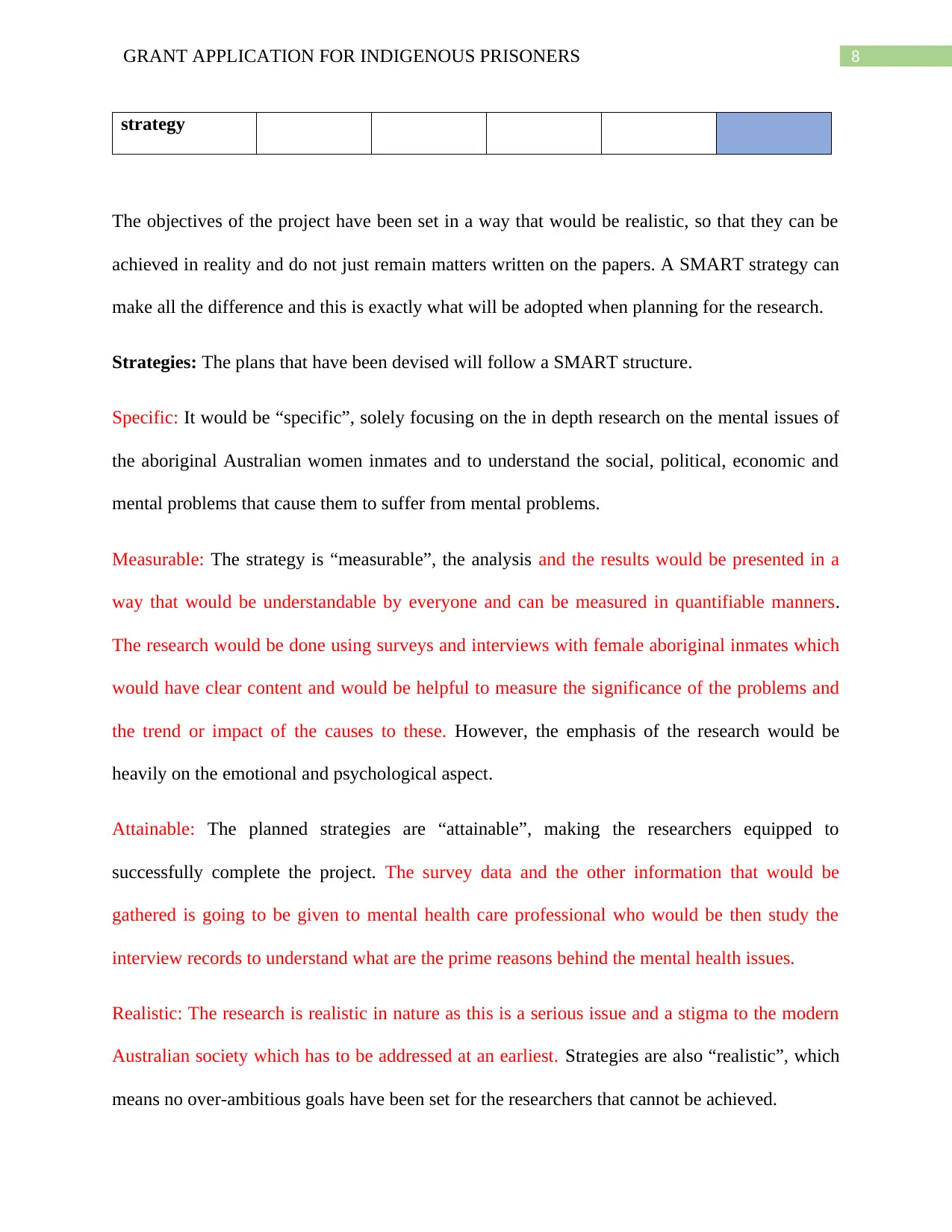
8GRANT APPLICATION FOR INDIGENOUS PRISONERS
strategy
The objectives of the project have been set in a way that would be realistic, so that they can be
achieved in reality and do not just remain matters written on the papers. A SMART strategy can
make all the difference and this is exactly what will be adopted when planning for the research.
Strategies: The plans that have been devised will follow a SMART structure.
Specific: It would be “specific”, solely focusing on the in depth research on the mental issues of
the aboriginal Australian women inmates and to understand the social, political, economic and
mental problems that cause them to suffer from mental problems.
Measurable: The strategy is “measurable”, the analysis and the results would be presented in a
way that would be understandable by everyone and can be measured in quantifiable manners.
The research would be done using surveys and interviews with female aboriginal inmates which
would have clear content and would be helpful to measure the significance of the problems and
the trend or impact of the causes to these. However, the emphasis of the research would be
heavily on the emotional and psychological aspect.
Attainable: The planned strategies are “attainable”, making the researchers equipped to
successfully complete the project. The survey data and the other information that would be
gathered is going to be given to mental health care professional who would be then study the
interview records to understand what are the prime reasons behind the mental health issues.
Realistic: The research is realistic in nature as this is a serious issue and a stigma to the modern
Australian society which has to be addressed at an earliest. Strategies are also “realistic”, which
means no over-ambitious goals have been set for the researchers that cannot be achieved.
strategy
The objectives of the project have been set in a way that would be realistic, so that they can be
achieved in reality and do not just remain matters written on the papers. A SMART strategy can
make all the difference and this is exactly what will be adopted when planning for the research.
Strategies: The plans that have been devised will follow a SMART structure.
Specific: It would be “specific”, solely focusing on the in depth research on the mental issues of
the aboriginal Australian women inmates and to understand the social, political, economic and
mental problems that cause them to suffer from mental problems.
Measurable: The strategy is “measurable”, the analysis and the results would be presented in a
way that would be understandable by everyone and can be measured in quantifiable manners.
The research would be done using surveys and interviews with female aboriginal inmates which
would have clear content and would be helpful to measure the significance of the problems and
the trend or impact of the causes to these. However, the emphasis of the research would be
heavily on the emotional and psychological aspect.
Attainable: The planned strategies are “attainable”, making the researchers equipped to
successfully complete the project. The survey data and the other information that would be
gathered is going to be given to mental health care professional who would be then study the
interview records to understand what are the prime reasons behind the mental health issues.
Realistic: The research is realistic in nature as this is a serious issue and a stigma to the modern
Australian society which has to be addressed at an earliest. Strategies are also “realistic”, which
means no over-ambitious goals have been set for the researchers that cannot be achieved.
⊘ This is a preview!⊘
Do you want full access?
Subscribe today to unlock all pages.

Trusted by 1+ million students worldwide
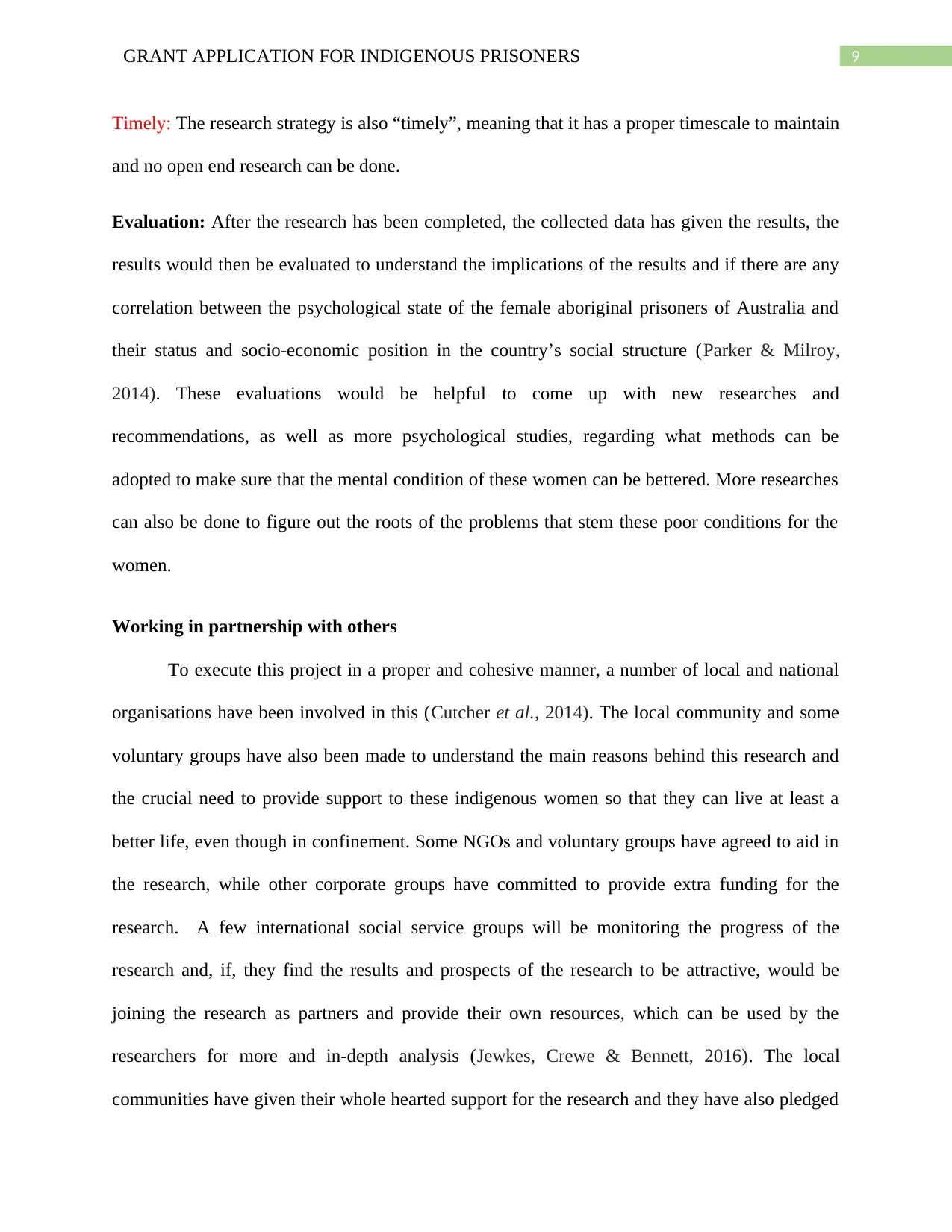
9GRANT APPLICATION FOR INDIGENOUS PRISONERS
Timely: The research strategy is also “timely”, meaning that it has a proper timescale to maintain
and no open end research can be done.
Evaluation: After the research has been completed, the collected data has given the results, the
results would then be evaluated to understand the implications of the results and if there are any
correlation between the psychological state of the female aboriginal prisoners of Australia and
their status and socio-economic position in the country’s social structure (Parker & Milroy,
2014). These evaluations would be helpful to come up with new researches and
recommendations, as well as more psychological studies, regarding what methods can be
adopted to make sure that the mental condition of these women can be bettered. More researches
can also be done to figure out the roots of the problems that stem these poor conditions for the
women.
Working in partnership with others
To execute this project in a proper and cohesive manner, a number of local and national
organisations have been involved in this (Cutcher et al., 2014). The local community and some
voluntary groups have also been made to understand the main reasons behind this research and
the crucial need to provide support to these indigenous women so that they can live at least a
better life, even though in confinement. Some NGOs and voluntary groups have agreed to aid in
the research, while other corporate groups have committed to provide extra funding for the
research. A few international social service groups will be monitoring the progress of the
research and, if, they find the results and prospects of the research to be attractive, would be
joining the research as partners and provide their own resources, which can be used by the
researchers for more and in-depth analysis (Jewkes, Crewe & Bennett, 2016). The local
communities have given their whole hearted support for the research and they have also pledged
Timely: The research strategy is also “timely”, meaning that it has a proper timescale to maintain
and no open end research can be done.
Evaluation: After the research has been completed, the collected data has given the results, the
results would then be evaluated to understand the implications of the results and if there are any
correlation between the psychological state of the female aboriginal prisoners of Australia and
their status and socio-economic position in the country’s social structure (Parker & Milroy,
2014). These evaluations would be helpful to come up with new researches and
recommendations, as well as more psychological studies, regarding what methods can be
adopted to make sure that the mental condition of these women can be bettered. More researches
can also be done to figure out the roots of the problems that stem these poor conditions for the
women.
Working in partnership with others
To execute this project in a proper and cohesive manner, a number of local and national
organisations have been involved in this (Cutcher et al., 2014). The local community and some
voluntary groups have also been made to understand the main reasons behind this research and
the crucial need to provide support to these indigenous women so that they can live at least a
better life, even though in confinement. Some NGOs and voluntary groups have agreed to aid in
the research, while other corporate groups have committed to provide extra funding for the
research. A few international social service groups will be monitoring the progress of the
research and, if, they find the results and prospects of the research to be attractive, would be
joining the research as partners and provide their own resources, which can be used by the
researchers for more and in-depth analysis (Jewkes, Crewe & Bennett, 2016). The local
communities have given their whole hearted support for the research and they have also pledged
Paraphrase This Document
Need a fresh take? Get an instant paraphrase of this document with our AI Paraphraser
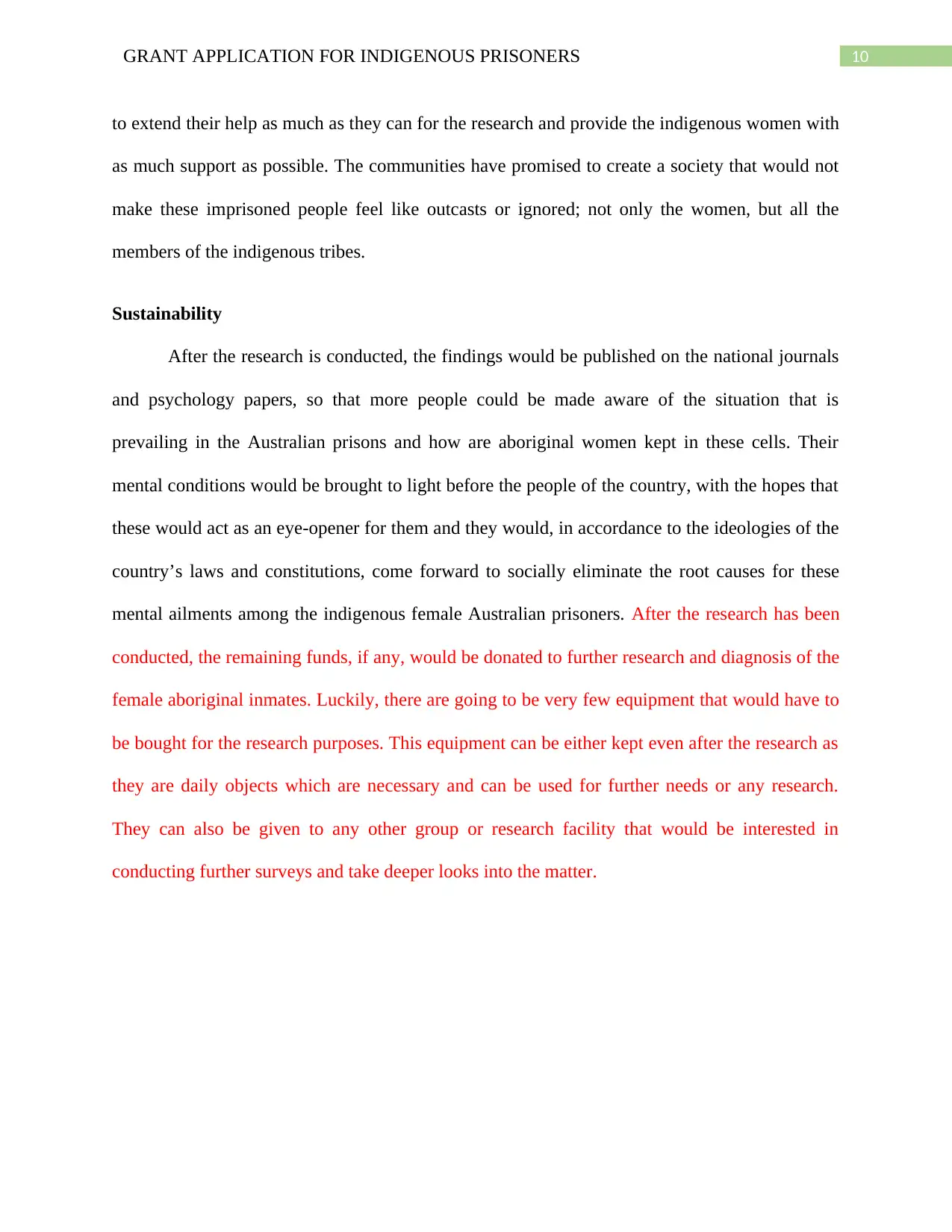
10GRANT APPLICATION FOR INDIGENOUS PRISONERS
to extend their help as much as they can for the research and provide the indigenous women with
as much support as possible. The communities have promised to create a society that would not
make these imprisoned people feel like outcasts or ignored; not only the women, but all the
members of the indigenous tribes.
Sustainability
After the research is conducted, the findings would be published on the national journals
and psychology papers, so that more people could be made aware of the situation that is
prevailing in the Australian prisons and how are aboriginal women kept in these cells. Their
mental conditions would be brought to light before the people of the country, with the hopes that
these would act as an eye-opener for them and they would, in accordance to the ideologies of the
country’s laws and constitutions, come forward to socially eliminate the root causes for these
mental ailments among the indigenous female Australian prisoners. After the research has been
conducted, the remaining funds, if any, would be donated to further research and diagnosis of the
female aboriginal inmates. Luckily, there are going to be very few equipment that would have to
be bought for the research purposes. This equipment can be either kept even after the research as
they are daily objects which are necessary and can be used for further needs or any research.
They can also be given to any other group or research facility that would be interested in
conducting further surveys and take deeper looks into the matter.
to extend their help as much as they can for the research and provide the indigenous women with
as much support as possible. The communities have promised to create a society that would not
make these imprisoned people feel like outcasts or ignored; not only the women, but all the
members of the indigenous tribes.
Sustainability
After the research is conducted, the findings would be published on the national journals
and psychology papers, so that more people could be made aware of the situation that is
prevailing in the Australian prisons and how are aboriginal women kept in these cells. Their
mental conditions would be brought to light before the people of the country, with the hopes that
these would act as an eye-opener for them and they would, in accordance to the ideologies of the
country’s laws and constitutions, come forward to socially eliminate the root causes for these
mental ailments among the indigenous female Australian prisoners. After the research has been
conducted, the remaining funds, if any, would be donated to further research and diagnosis of the
female aboriginal inmates. Luckily, there are going to be very few equipment that would have to
be bought for the research purposes. This equipment can be either kept even after the research as
they are daily objects which are necessary and can be used for further needs or any research.
They can also be given to any other group or research facility that would be interested in
conducting further surveys and take deeper looks into the matter.
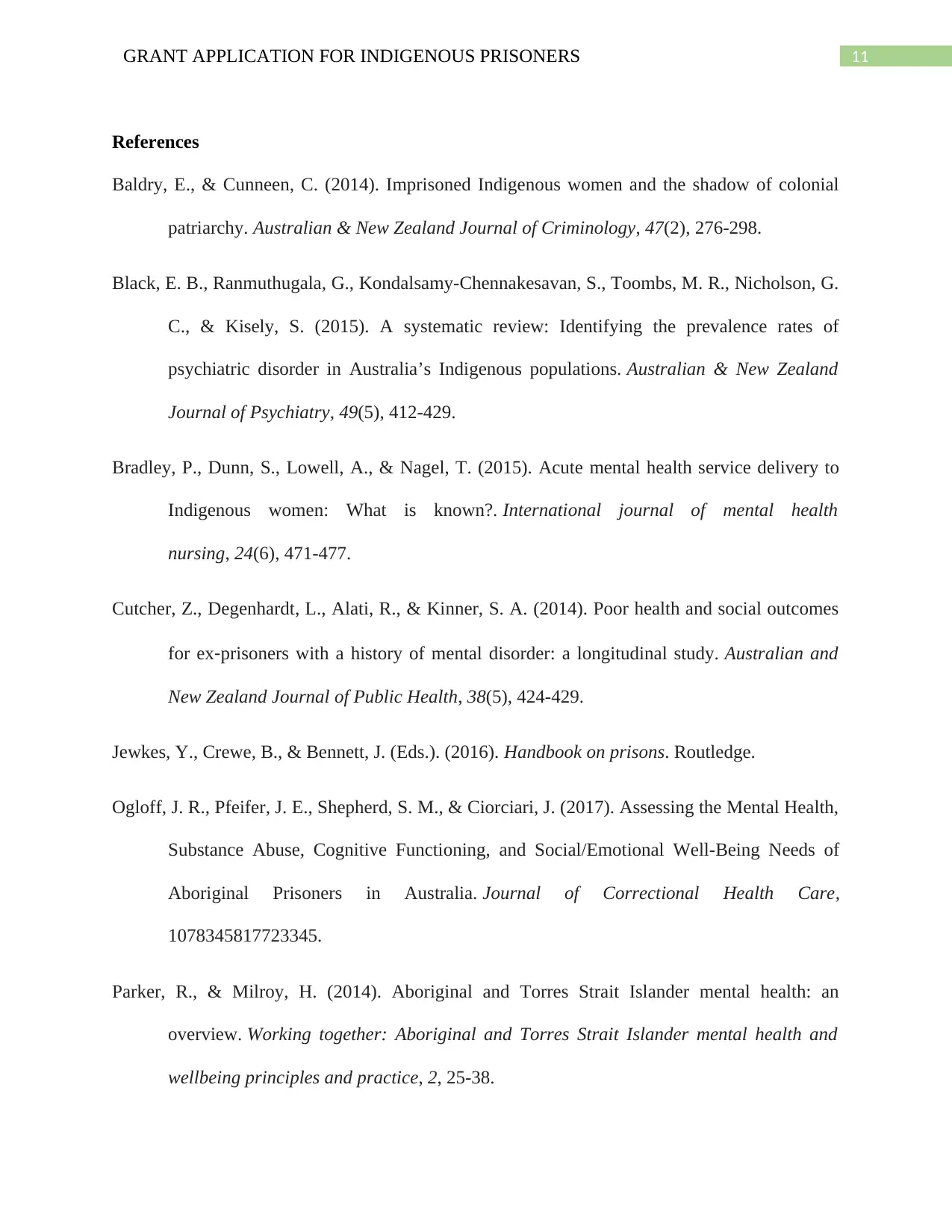
11GRANT APPLICATION FOR INDIGENOUS PRISONERS
References
Baldry, E., & Cunneen, C. (2014). Imprisoned Indigenous women and the shadow of colonial
patriarchy. Australian & New Zealand Journal of Criminology, 47(2), 276-298.
Black, E. B., Ranmuthugala, G., Kondalsamy-Chennakesavan, S., Toombs, M. R., Nicholson, G.
C., & Kisely, S. (2015). A systematic review: Identifying the prevalence rates of
psychiatric disorder in Australia’s Indigenous populations. Australian & New Zealand
Journal of Psychiatry, 49(5), 412-429.
Bradley, P., Dunn, S., Lowell, A., & Nagel, T. (2015). Acute mental health service delivery to
Indigenous women: What is known?. International journal of mental health
nursing, 24(6), 471-477.
Cutcher, Z., Degenhardt, L., Alati, R., & Kinner, S. A. (2014). Poor health and social outcomes
for ex‐prisoners with a history of mental disorder: a longitudinal study. Australian and
New Zealand Journal of Public Health, 38(5), 424-429.
Jewkes, Y., Crewe, B., & Bennett, J. (Eds.). (2016). Handbook on prisons. Routledge.
Ogloff, J. R., Pfeifer, J. E., Shepherd, S. M., & Ciorciari, J. (2017). Assessing the Mental Health,
Substance Abuse, Cognitive Functioning, and Social/Emotional Well-Being Needs of
Aboriginal Prisoners in Australia. Journal of Correctional Health Care,
1078345817723345.
Parker, R., & Milroy, H. (2014). Aboriginal and Torres Strait Islander mental health: an
overview. Working together: Aboriginal and Torres Strait Islander mental health and
wellbeing principles and practice, 2, 25-38.
References
Baldry, E., & Cunneen, C. (2014). Imprisoned Indigenous women and the shadow of colonial
patriarchy. Australian & New Zealand Journal of Criminology, 47(2), 276-298.
Black, E. B., Ranmuthugala, G., Kondalsamy-Chennakesavan, S., Toombs, M. R., Nicholson, G.
C., & Kisely, S. (2015). A systematic review: Identifying the prevalence rates of
psychiatric disorder in Australia’s Indigenous populations. Australian & New Zealand
Journal of Psychiatry, 49(5), 412-429.
Bradley, P., Dunn, S., Lowell, A., & Nagel, T. (2015). Acute mental health service delivery to
Indigenous women: What is known?. International journal of mental health
nursing, 24(6), 471-477.
Cutcher, Z., Degenhardt, L., Alati, R., & Kinner, S. A. (2014). Poor health and social outcomes
for ex‐prisoners with a history of mental disorder: a longitudinal study. Australian and
New Zealand Journal of Public Health, 38(5), 424-429.
Jewkes, Y., Crewe, B., & Bennett, J. (Eds.). (2016). Handbook on prisons. Routledge.
Ogloff, J. R., Pfeifer, J. E., Shepherd, S. M., & Ciorciari, J. (2017). Assessing the Mental Health,
Substance Abuse, Cognitive Functioning, and Social/Emotional Well-Being Needs of
Aboriginal Prisoners in Australia. Journal of Correctional Health Care,
1078345817723345.
Parker, R., & Milroy, H. (2014). Aboriginal and Torres Strait Islander mental health: an
overview. Working together: Aboriginal and Torres Strait Islander mental health and
wellbeing principles and practice, 2, 25-38.
⊘ This is a preview!⊘
Do you want full access?
Subscribe today to unlock all pages.

Trusted by 1+ million students worldwide
1 out of 13
Related Documents
Your All-in-One AI-Powered Toolkit for Academic Success.
+13062052269
info@desklib.com
Available 24*7 on WhatsApp / Email
![[object Object]](/_next/static/media/star-bottom.7253800d.svg)
Unlock your academic potential
Copyright © 2020–2025 A2Z Services. All Rights Reserved. Developed and managed by ZUCOL.





